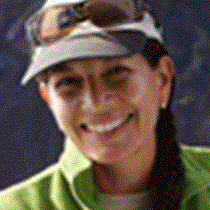Isabela and Fernandina Islands
Early in the morning we woke up at the northwest tip of Isabela, near Wolf and Ecuador volcanoes. Here, the frigid waters of the deep equatorial counter-current rise up along the western edge of the undersea Galápagos Platform. At times this upwelling phenomenon can be responsible for thick sea fogs and remarkably cool sea temperatures, which occasionally drop as low as the mid-50’s Fahrenheit. These extraordinary conditions are also at the heart of a very rich marine ecosystem, at times attracting whales and dolphins to the region, and therefore before breakfast, we invited everybody to meet at the bow of the ship with binoculars and cameras in the search of these fantastic marine mammals.
The day was a bit cloudy but the ocean was calm with a pleasant air temperature. After a little while, we spotted what we think was a Bryde’s whale, a common baleen whale found in this latitude at this time of year. We turned the ship around several times, following the whale that was a bit elusive, and finally we spotted it again, so it was worthwhile to get up early!
After breakfast, we dropped anchor at the southern end of Ecuador Volcano. This spectacular shield volcano, which is bisected by the equator, collapsed and slumped away into the ocean, leaving fascinating views of the inner caldera wall and the caldera floor. Once our Zodiacs were deployed, our Zodiac driver, Victor, drove us along the imposing cliffs of Punta Vicente Roca, allowing us to see fur seals on the rocky shores and playing in the water, marine iguanas swimming or feeding on algae, brown noddy terns and blue-footed boobies perched on the cliff as well as flightless cormorants drying their tiny wings and penguins fishing around, not to mention the spectacular landscape of the inner caldera and the lava dikes.
Later we went back again to the cove of Punta Vicente Roca, but this time with our snorkel gear and the underwater camera. The snorkeling was outstanding; we counted more than 60 sea turtles lying on the sandy bottom, huge females and males and some juveniles. We also saw flightless cormorants courting and displaying their mating behavior on the water and even a male sea lion courting a female, like in a ballet dance!
We sailed onward to Fernandina, another imposing volcano rising to nearly 5,000 feet in elevation, and one of the most active volcanoes in the world. Fernandina is also the world's largest pristine island. Our landing site for the afternoon was at Punta Espinosa, the only visitor site on this island. The walk was mostly over solid black slabs of ropy lava, referred to by the Hawaiian term pahoehoe, where hundreds of large marine iguanas were basking on the dark lava, while sea lions, flightless cormorants, herons and even sea turtles were easy to spot.
On the way back to the ship, the silhouette of Fernandina against a fantastic sunset reminded us how lucky we were to be able to visit such a pristine place, unique on earth.




